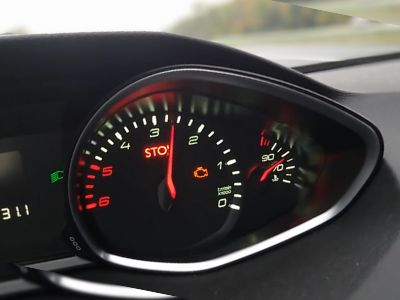You could just be casually driving your Peugeot 308, when the dreaded “Engine Fault Repair Needed” warning lights up on the dashboard. This severe warning indicator is enough to make any car owner’s heart race with worry.
So what’s gone wrong? How urgent is it? Before you let fear take the wheel, our crew at Driver Moola are here to guide you.
This guide will break down the possible causes behind this warning (such as fuel pump failures, faulty recirculation valve, etc), and common situations that bring up the “Engine Fault Repair Needed” warning.
Also, we’ll provide you with recommended steps to take. Read on!

Peugeot 308
The Peugeot 308, a compact yet powerful car by the renowned French automaker Peugeot, has won hearts worldwide with its fuel efficiency and dynamic design. The latest version boasts a fresh design and comes in various models, including the practical family estate 308 SW and the high-performance 308 GTi.
A standout feature is the unique i-Cockpit, which includes a compact steering wheel, head-up instrument panel, and touchscreen display. This vehicle’s appeal is further cemented by the positive reviews it has received, with many comparisons favorably placing it alongside other cars in its class.
Peugeot 308: “Engine Fault Repair Needed” Causes
When your Peugeot 308 flashes the “Engine Fault Repair Needed” warning, it’s like your car is sending you an SOS. There could be various culprits behind this, from simple issues such as faulty spark plugs to more complex problems like a bad high-pressure fuel pump.
Here are some potential suspects:

High-Pressure Fuel Pump Failure
One of the most common reasons for encountering the warning message is a high-pressure fuel pump failure. This crucial component is responsible for supplying fuel to the engine at the precise pressure required for optimal performance. When the high-pressure fuel pump malfunctions, it hampers the fuel delivery process, leading to engine start-up issues or a decrease in engine performance. As a result, the onboard diagnostics system detects the problem and promptly notifies the driver through the warning message, prompting them to seek timely repairs or replacements.
Bad Spark Plugs And Ignition Coil
The ignition system plays a critical role in the proper functioning of the engine. If the spark plugs or ignition coils are faulty, they can cause misfires in the engine. Spark plugs are responsible for igniting the fuel-air mixture in the engine’s cylinders, while the ignition coils provide the necessary high voltage to create the spark. A misfire can disrupt the engine’s smooth operation, causing fluctuations in power and performance. When the vehicle’s sensors detect these irregularities, the warning message is triggered to alert the driver of the issue, emphasizing the need for immediate attention to prevent further damage to the engine.
Faulty Recirculation Valve
The recirculation valve, also known as the EGR (Exhaust Gas Recirculation) valve, serves a crucial role in reducing emissions and maintaining the engine’s combustion efficiency. The recirculation valve recirculates a portion of the exhaust gases back into the engine’s intake system to lower harmful emissions. However, when this valve fails to function correctly, it can disrupt the engine’s air-to-fuel ratio, leading to poor engine performance and increased emissions. The vehicle’s electronic control unit identifies this anomaly and triggers the warning message to inform the driver of the potential environmental and performance issues that require immediate attention.
Bad Battery
The battery is the lifeblood of the vehicle’s electrical system, providing the necessary power to start the engine and operate various electrical components. When the battery is weak or dead, it cannot supply sufficient power to start the engine, leading to starting difficulties. Moreover, a failing battery may not effectively support the vehicle’s electrical demands, causing erratic behavior in electronic systems. The warning message acts as an alert for the driver to address the battery issue promptly, as it can significantly impact the vehicle’s reliability and overall performance.
Faulty Turbo
In vehicles equipped with a turbocharger, this component plays a crucial role in boosting the engine’s power output. By compressing the incoming air, the turbocharger allows the engine to burn more fuel and produce more power. However, a faulty turbo can disrupt this process, leading to a loss of power and reduced engine performance. The warning message is triggered when the vehicle’s sensors detect a drop in power output or abnormalities in the turbocharging system, signaling the need for immediate inspection and repair to restore the engine’s full capabilities.
Bad Camshaft Position Sensor
The camshaft position sensor is vital for the engine’s precise timing and performance. The camshaft position sensor provides critical information about the camshaft’s position to the engine control module (ECM), allowing the ECM to manage fuel injection, ignition timing, and other vital processes accurately. When the camshaft position sensor malfunctions, the ECM may receive incorrect data, leading to misfires and irregular engine operation. The warning message is activated as soon as the ECM identifies these irregularities, prompting the driver to address the issue promptly to prevent potential engine damage.
Bad/Clogged Catalytic Converter
The catalytic converter is an essential emissions control device responsible for converting harmful pollutants in exhaust gases into less harmful compounds. When the catalytic converter becomes damaged or clogged due to engine issues or other factors, the catalytic converter restricts the exhaust flow, resulting in poor engine performance and increased emissions. The warning message serves as an indicator to the driver that the catalytic converter requires attention and possible replacement, as its proper functioning is crucial for the vehicle’s environmental compliance and overall engine efficiency.
Another Common Situation: “Engine Fault Repair Needed” and Eco Mode Deactivates
Sometimes, a situation that arises is when the Eco mode also deactivating along with the “Engine Fault Repair Needed” warning. This could be due to issues like the Engine ECU not recognizing a new battery. We’ll help you untangle this twist and get your car back on track.
Engine ECU Does Not Recognize New Battery
When the Engine Control Unit (ECU) doesn’t recognize a new battery, it can lead to a number of issues, including the deactivation of Eco mode and the triggering of the “Engine Fault Repair Needed” warning. This is often due to the ECU’s inability to adapt to the change in voltage supplied by the new battery. The ECU is essentially the brain of your car’s engine. It controls a series of actuators on an internal combustion engine to ensure optimal engine performance.
The solution: After you put a new battery in your car, it’s really important to do a calibration process to make sure the car’s computer (ECU) knows about the new battery. If you don’t do this calibration, the car’s computer won’t be able to recognize that there’s a new battery in the car.
What To Do When Your Peugeot 308 Displays The “Engine Fault Repair Needed” Message?
If you’re getting an “Engine Fault Repair Needed” message on your Peugeot, there are a few steps to follow.
First, get an OBD scanner (which helps pinpoint the exact issues). Second, take the car for diagnostics. If the error is not bad enough to turn on the check engine light, then it will be hard to diagnose what’s wrong with your car.
If you have taken it in and they say that it isn’t anything serious and that they can’t find any issues with it, then try doing some research online. You can find more information about your specific model of Peugeot to see if there is any common issue associated with it or if there are any recalls on your specific model number (which may lead to a repair).
If all else fails, contact Peugeot themselves to see if they can help you out with any recommendations or other options for getting this problem fixed without having to pay for expensive repairs or replacements
Final Notes
From a high-pressure fuel pump failure to a bad or clogged catalytic converter, there are many reasons why your vehicle’s “Engine Fault Repair Needed” warning message may be triggered.
Diagnose the exact issue as soon as possible in order to prevent potential engine damage. With the help of an OBD scanner and professional diagnostics, you can determine what exactly needs repair or replacement on your car so that you can get back out on the road with minimal disruptions. If all else fails, contact Peugeot themselves for further assistance – they may even provide some recommendations or solutions without needing expensive repairs!
Remember: an ounce of prevention is worth a pound of cure. So if you notice any warning messages on your dashboard or experience any issues with your vehicle, address them immediately to avoid further complications and keep your car running in optimal condition. Take the time to regularly inspect and maintain your vehicle, so that you can rest assured knowing that your car is in good hands.

Robert Anderson is a world class motorhead who rebuilt his first carb at age 10, his first engine at age 15, and completed his first full hotrod build when he was just 18! Previously, he has ran a part warehouse, delivered pizzas, and managed the service department for a $20 million/year revenue dealership. Robert knows cars like few others and he is passionate about sharing his knowledge.
